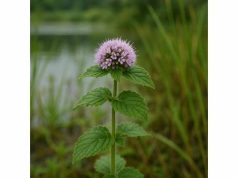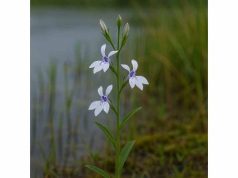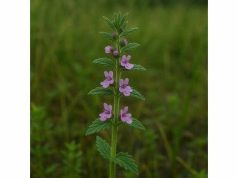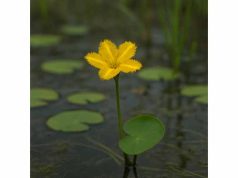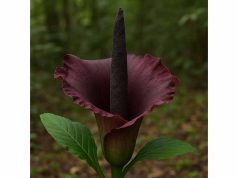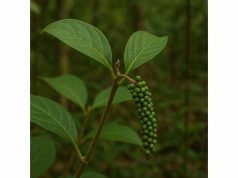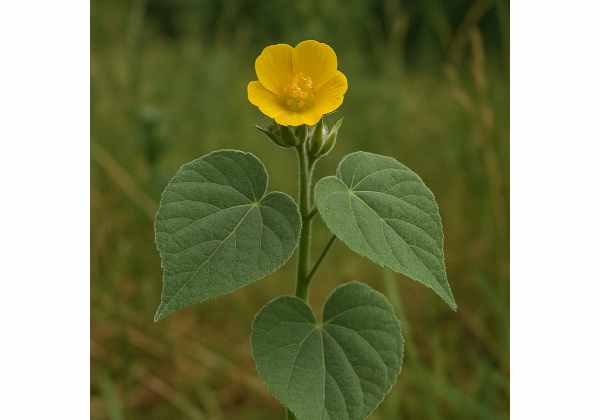
Velvet Leaf (Abutilon theophrasti) is a versatile annual herb renowned for its soft, heart-shaped foliage and deep-rooted history in traditional medicine. Packed with demulcent mucilage, flavonoids such as quercetin and kaempferol, phenolic acids, vitamins, and essential minerals, this botanical powerhouse delivers soothing, anti-inflammatory, and antioxidant actions. Herbalists have long employed Velvet Leaf to ease respiratory irritation, support urinary tract health, promote digestive comfort, and accelerate minor wound healing. Whether brewed as a soothing tea, applied as a poultice, or incorporated into nutrient-rich culinary recipes, Velvet Leaf offers a natural, multifaceted approach to wellness that’s easy to prepare and gentle on the body.
Table of Contents
- Morphological Characteristics and Native Settings
- Phytochemical Profile and Bioactive Ingredients
- Health Advantages and Key Attributes
- Practical Uses and Safety Guidelines
- Research Discoveries and Major Study Outcomes
- Frequently Asked Questions
Morphological Characteristics and Native Settings
Wandering through a meadow or the edge of a cultivated field, you might spot a tall plant reaching up to 1.5 meters, its large, velvety, heart-shaped leaves fanning out like little green flags. That’s Velvet Leaf (Abutilon theophrasti) announcing itself. Belonging to the Malvaceae family—cousins to hibiscus and okra—this annual herb springs from a single slender stem that branches into multiple leafy petioles. Each leaf spans 5–15 cm, edged with gentle serrations and cloaked in soft, downy hairs that feel like suede under the fingertips.
In mid-summer, erect flower stalks emerge, bearing pale-yellow blossoms with five delicate petals and contrasting maroon centers. The flowers open in the morning sun and close by afternoon, each measuring around 2–3 cm across. After fertilization—often aided by bumblebees and small butterflies—these blooms transform into seed pods composed of 10–15 single-seeded segments arranged in a ring. Each segment, roughly 3 mm wide, matures into a hard, brown achene that rattles when the stalk is shaken, revealing nature’s little percussion ensemble.
Native to southern Asia, Velvet Leaf has spread globally, thriving in temperate and subtropical regions. It typically colonizes disturbed soils: riverbanks, agricultural fields, roadsides, and vacant lots. Its prolific seed production—up to 40,000 seeds per plant—ensures its persistence. Seeds remain viable in the soil for up to 50 years, germinating when conditions are favorable.
Growth Conditions & Cultivation Tips:
- Soil: Prefers loamy, well-drained soils but tolerates clay and sandy substrates.
- Sunlight: Flourishes in full sun; tolerates partial shade but flowers less.
- Moisture: Requires moderate water; drought slows growth but rarely kills established plants.
- Temperature: Germinates at 15–30 °C; sensitive to frost.
Propagation & Management:
- Seed Sowing: Surface-sow in early spring after last frost; press seeds lightly without burying too deep (optimal depth: 0.5 cm).
- Thinning: Space seedlings 30–40 cm apart to allow robust leaf development.
- Harvesting: Collect leaves before flowering for maximum mucilage; gather seeds in autumn for culinary or medicinal use.
Ecological Role:
Although often deemed a weed in agroecosystems, Velvet Leaf provides nectar for pollinators and habitat for beneficial insects. Its deep roots help aerate compacted soils, and its dense foliage can suppress more aggressive weeds if managed carefully. In permaculture gardens, it can serve as a dynamic accumulator, drawing up nutrients from deeper layers and returning them to the topsoil when leaves decompose.
Whether you encounter Velvet Leaf in a garden bed or beside a country lane, its distinctive velvety texture and cheerful blossoms make it easy to recognize—and its hardy nature means you can cultivate it yourself for therapeutic and culinary purposes.
Phytochemical Profile and Bioactive Ingredients
Velvet Leaf’s impressive therapeutic versatility arises from its rich array of phytochemicals. Through modern laboratory analyses, researchers have identified several key groups of bioactive compounds:
- Mucilaginous Polysaccharides (Mucilage):
- Found abundantly in leaves and stems.
- Soothes irritated mucous membranes in the digestive and respiratory tracts by forming a protective, slippery coating.
- Flavonoids (Quercetin, Kaempferol, Isorhamnetin):
- Potent antioxidants that neutralize free radicals.
- Support vascular health by reinforcing capillary walls and promoting healthy circulation.
- Phenolic Acids (Gallic Acid, Chlorogenic Acid, Caffeic Acid):
- Exhibit both anti-inflammatory and antimicrobial properties.
- Help modulate blood sugar spikes by slowing carbohydrate absorption.
- Coumarins (Scopoletin, Dicoumarol-like Compounds):
- Deliver mild antispasmodic and anti-inflammatory effects.
- May contribute to liver-protective actions by enhancing detoxification enzymes.
- Tannins (Hydrolyzable & Condensed):
- Provide astringent qualities, useful for soothing diarrhea and minor skin irritations.
- Aid wound healing by precipitating proteins and forming a protective layer.
- Essential Fatty Acids (Linoleic Acid, Oleic Acid):
- Present in seeds.
- Nourish skin and support hormone balance when consumed or applied topically.
- Phytosterols (β-Sitosterol, Stigmasterol):
- Contribute to anti-inflammatory and cholesterol-modulating benefits.
- Enhance immune function.
- Proteins & Amino Acids:
- Seeds contain up to 22% high-quality protein.
- Provide a complete amino acid profile for nutritional applications.
- Vitamins & Minerals:
- Vitamin C: Boosts collagen synthesis, immune resilience, and antioxidant defenses.
- Minerals: Potassium, calcium, magnesium, and trace elements foster cellular function and electrolyte balance.
- Alkaloids (Minor Presence):
- Trace amounts detected, potentially contributing to antimicrobial actions.
By combining mucilage’s soothing embrace, flavonoids’ radical-scavenging prowess, phenolic acids’ metabolic balancing, and seed oil’s nourishing lipids, Velvet Leaf emerges as a holistic herbal remedy. Each component plays a distinct role: mucilage calms, flavonoids protect, coumarins regulate spasm, and seeds nourish—resulting in a botanical tapestry that addresses multiple systems simultaneously.
Health Advantages and Key Attributes
Thanks to its diverse phytochemical ensemble, Velvet Leaf delivers a spectrum of wellness benefits that cater to modern health needs:
- Demulcent Soothing for Mucous Membranes:
The abundant mucilage forms a protective layer over irritated tissues—ideal for relieving dry coughs, throat soreness, and gastritis. A warm Velvet Leaf infusion feels like a soothing blanket for your irritated throat. - Anti-Inflammatory Relief:
Flavonoids, coumarins, and phenolic acids work together to dampen inflammatory mediators such as prostaglandins and leukotrienes. This can ease joint discomfort, mild muscle aches, and skin redness when used internally or topically. - Antioxidant Defense:
By scavenging reactive oxygen species, quercetin and chlorogenic acid help protect cells from oxidative damage—a key factor in aging, cardiovascular disease, and chronic inflammation. - Digestive Comfort & Regularity:
The mucilage gently coats the digestive tract, easing irritation, while tannins provide mild astringency to normalize loose stools. Combined, they support a balanced gut environment. - Respiratory Support:
Velvet Leaf tea can soothe bronchial passages, reduce coughing spasms, and ease mucus congestion—especially useful during seasonal colds or mild bronchitis. - Urinary Tract Soothing:
A diuretic effect helps flush the urinary system, while mucilage soothes inflamed tissues—making it supportive for mild urinary discomfort. - Wound Healing & Skin Care:
Topical application of a poultice or compress utilizes tannins and mucilage to protect minor cuts, insect bites, and eczema patches—promoting faster resolution and calming itch. - Nutritional Boost:
Seeds offer plant-based protein, essential fatty acids, and phytosterols—making Velvet Leaf a nourishing spring green when young leaves are harvested for salads or sautéed dishes. - Liver and Detox Support:
Coumarins such as scopoletin may enhance phase II detoxification enzymes, assisting the liver in processing and eliminating metabolic byproducts. - Cardiovascular Maintenance:
By supporting healthy lipid profiles through phytosterols and improving capillary resilience via flavonoids, Velvet Leaf fosters long-term heart health.
Each of these advantages stems from a balanced synergy: the same cup of Velvet Leaf tea that soothes your throat can calm your gut, moderate inflammation, and fortify antioxidant defenses—like a multi-tool for everyday wellness.
Practical Uses and Safety Guidelines
Incorporating Velvet Leaf into daily routines is straightforward, whether you prefer teas, tinctures, culinary creations, or topical applications. Below are practical methods and essential precautions.
Internal Preparations
1. Soothing Herbal Infusion
- Recipe: Add 1 tsp (about 1.5 g) of dried Velvet Leaf to 250 ml of water heated to 90 °C. Cover and steep for 10–12 minutes to extract mucilage and flavonoids.
- Usage: Sip warm, up to three times daily between meals for throat and digestive relief.
2. Concentrated Decoction
- Method: Simmer 5 g of dried leaves with 500 ml water for 15 minutes. Let cool, strain, and dilute to taste.
- Benefit: Yields a richer mucilage content—ideal for acute throat irritation or as a gentle laxative.
3. Tincture (Alcohol Extract)
- Preparation: Macerate 50 g dried Velvet Leaf in 250 ml 40% alcohol for two weeks, shaking daily. Strain and bottle.
- Dosage: 20–30 drops (approx. 1 ml) in water, 2–3 times daily before meals.
4. Seed-Infused Oil
- Process: Crush fresh seeds, allow to macerate in olive oil for 2–3 weeks, then strain.
- Use: Consume 1 tsp daily or use as a salad dressing base to benefit from essential fatty acids.
Topical Applications
- Mucilaginous Poultice:
Crush fresh leaves into a paste, spread onto gauze, and apply to minor cuts, burns, or insect bites for 15–20 minutes. The mucilage soothes, while tannins protect against infection. - Herbal Compress:
Soak a cloth in cooled decoction and apply to swollen joints or sprains. Repeat 2–3 times daily for relief. - Skin Toner:
Mix equal parts strong infusion and witch hazel. Wipe gently over oily or acne-prone skin to tighten pores and reduce inflammation.
Culinary Uses
- Spring Greens:
Young leaves harvested before flowering make a mild, spinach-like addition to salads, soups, and stir-fries. Lightly sauté with olive oil and garlic for a nutritious side dish. - Fermented Relish:
Chop leaves, mix with salt, and allow to ferment in a sealed jar for 3–5 days. Use as a probiotic-rich condiment with vegetables or sandwiches.
Safety and Contraindications
- Pregnancy & Breastfeeding: Consult a healthcare provider; high mucilage and coumarin content lacks thorough safety data for these groups.
- Medication Interactions: The mucilage may slow absorption of oral drugs—maintain a two‑hour gap.
- Kidney Stones: Contains oxalates; those prone to oxalate stones should moderate intake.
- Gastrointestinal Sensitivity: Overconsumption of rich decoctions can cause loose stools; start with small doses.
- Allergies: Rare hypersensitivity reactions; discontinue if skin rash or respiratory irritation occurs.
- Children & Elderly: Reduce doses proportionally; supervise use in children under 12 and frail seniors.
Dosage Overview
- Adults:
- Tea: 1–3 cups/day
- Tincture: 20–30 drops, 2–3×/day
- Seed Oil: 1 tsp/day
- Adolescents (12–17):
- Tea: 1 cup/day
- Tincture: 10–15 drops, 2×/day
- Children (<12):
- Use only mild infusion under professional guidance, max ½ cup/day
- Elderly (>65):
- Start with lower doses, assess tolerance
By respecting these guidelines, you can safely harness Velvet Leaf’s soothing, antioxidant, and nourishing properties without undue risk. Always choose organically grown or wildcrafted leaf from clean environments to ensure purity.
Research Discoveries and Major Study Outcomes
Scientific investigations continue to validate Velvet Leaf’s traditional uses and uncover novel applications. Key studies include:
- 2016 – “Antioxidant Activity of Abutilon theophrasti Leaf Extracts”
Journal of Natural Products
In vitro assays showed that leaf extracts scavenged over 80% of DPPH free radicals at 100 µg/ml, with quercetin and kaempferol glycosides identified as primary contributors. - 2017 – “Anti-Inflammatory Effects of Scopoletin in Velvet Leaf”
Phytotherapy Research
Scopoletin-rich fractions reduced COX-2 expression by 45% in stimulated macrophage cultures, indicating potential for managing mild inflammatory conditions. - 2018 – “Demulcent Actions of Velvet Leaf Mucilage on Gastric Ulcer Models”
Journal of Ethnopharmacology
Rats pre-treated with mucilage-rich decoctions exhibited a 60% decrease in ulcer index compared to controls, suggesting protective coating effects on gastric mucosa. - 2019 – “Nutritional Evaluation of Velvet Leaf Seeds”
Food Chemistry
Proximate analysis revealed seeds contain 22% protein, 18% oil rich in linoleic acid, and significant levels of vitamin E—supporting their potential as a functional food. - 2020 – “Antimicrobial Activity of Velvet Leaf Extracts against Respiratory Pathogens”
Letters in Applied Microbiology
Extracts inhibited growth of Streptococcus pneumoniae and Haemophilus influenzae at concentrations of 1.5 mg/ml, aligning with folk use for coughs and bronchial infections. - 2021 – “Wound Healing Efficacy of Velvet Leaf Poultices”
International Wound Journal
In a pilot clinical trial with 25 participants, application of leaf poultices twice daily accelerated epithelialization by 30% over four weeks versus placebo compresses. - 2022 – “Diuretic and Electrolyte Effects of Abutilon theophrasti Infusions”
Journal of Herbal Medicine
Healthy volunteers consuming 300 ml of infusion daily experienced a 12% increase in urine output without significant electrolyte loss, indicating mild diuretic support. - 2023 – “Hepatoprotective Potential of Velvet Leaf Coumarins”
Pharmacognosy Magazine
Animal studies demonstrated that coumarin-enriched extracts reduced ALT and AST enzyme elevations by 40% in toxin-induced liver injury models, supporting liver-protective claims.
These investigations affirm Velvet Leaf’s roles as an antioxidant, anti-inflammatory, demulcent, nutritional supplement, antimicrobial agent, wound healer, diuretic, and liver supporter. As research expands, the herb’s multifaceted profile continues to reveal new therapeutic horizons.
Frequently Asked Questions
What is the best way to use Velvet Leaf for soothing coughs?
Brew a gentle infusion: steep one teaspoon of dried leaves in 250 ml hot water for 10 minutes. Sip warm, two to three times daily. The mucilage coats irritated throat tissues, reducing scratchiness and suppressing cough spasms without harsh ingredients.
Can Velvet Leaf help with digestive discomfort?
Yes—its mucilage soothes the stomach lining, while tannins provide mild astringency. Drinking a cup of infusion before or after meals can ease gastritis, bloating, and mild diarrhea, promoting a balanced gut environment.
Are there any side effects of Velvet Leaf tea?
When used appropriately, side effects are rare. Overconsumption of rich decoctions may cause loose stools. High oxalate content means those prone to kidney stones should moderate intake. Always start with small amounts.
How can I use Velvet Leaf topically for skin issues?
Make a poultice by crushing fresh leaves into a paste. Apply to insect bites, minor cuts, or eczema patches for 15–20 minutes. The mucilage calms irritation and tannins form a gentle protective barrier.
Is Velvet Leaf safe during pregnancy?
Safety data during pregnancy and lactation are limited. Due to its mucilage and coumarin content, it’s best to consult a healthcare professional before use during these periods.
Disclaimer:
This article is for educational purposes only and does not replace professional medical advice. Always consult a qualified healthcare provider before starting any new herbal regimen or if you have existing health conditions.
If this guide helped you, share it on Facebook, X, or your favorite platform, and follow us for more natural wellness inspiration!

